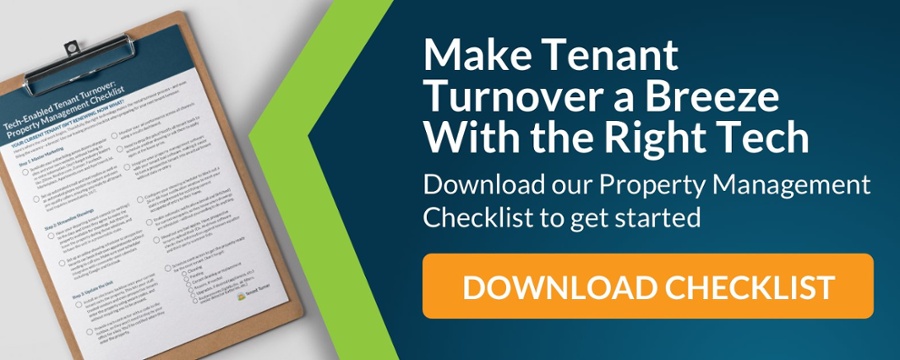Renting out a residential property can be a pain for most property managers. Whether you’re leasing a new property to tenants for the first time or turning over a unit to a new tenant, there’s a long list of property management tasks to take care of before you start collecting rental income.
The good news is that technology has made things easier for rental property owners and managers. Automation solutions streamline a lot of property management administrative busywork. With the right property management software, the process of rental turnover and filling vacancies is easier and more efficient than ever.
Property Management Checklist for Residential Properties
Automation software combined with a buttoned-up process can slash your time and effort.
Here’s our Top 5 list of the most important to-dos that every rental property manager should take care of before renting their residential property.
#1 List and Market Your Property
Once a tenant gives notice that they’ll be vacating your rental, the real work begins. Marketing your residential property is an essential first step to get a new tenant as soon as possible.
With the help of Tenant Turner scheduling software, you can syndicate your online listing on your website as well as across many popular housing websites. Be sure to include industry powerhouses such as Zumper, Apartments.com, and Zillow. Once you enter the listing information into Tenant Turner, you won’t have to do it again.
With property management software, you won’t waste time maintaining your property listing across various sites or keeping up with leads in your email.
If a property has been vacant for a while and you determine that you need to lower the rental price, you can notify your tenant leads through a centralized CRM, inviting them to apply again at the new prices. Or, if a prospective tenant misses out on a great property, you can easily redirect them to another one of your available units and schedule a rental showing.
Once you have an interested lead, use automation to save valuable time. Create automated replies to texts and emails from prospective tenants. You can also set up an automated phone system to never lose a potential quality lead, even if they call after hours.
Boost your rental prospect marketing and intake to the next level by pre-qualifying callers. With this system in place, you can attend to all tenant inquiries instantly at any time of the day.
By integrating your property management software with tenant lead software, you simplify your rental property marketing process and turning potential tenants into actual renters becomes easy.
#2 Conduct Rental Showings
After marketing your property and attracting prospective tenants, efficiently schedule and show them your property. Of course, you can’t expect your prospects to rent a unit without first assessing what it looks like and if it will meet their needs.
Once you’ve acquired an interested tenant lead, it’s time to make the showing process as easy as possible. With an online showing scheduler, you can automate aspects of the showing process. Allow tenants to book a time that works best for them without the back and forth of multiple phone calls just to book the property showing.
Before providing showing times for a property, be sure to work with the tenant who's leaving to establish when they intend to move out. You may need to work with them to find times for showing the property when they are still living there.
When your current tenant does move out, schedule time to inspect the property to ensure they left everything in a good condition. If you’re allowing self-showings, you’ll definitely want to do a walkthrough to make sure the property is presentable to prospective tenants.
On-demand webinar: Reduce Vacancy and Scams with Self-showings
To make your property showings smooth and efficient, use automation to notify current tenants when showings have been scheduled. You can do this by enabling automatic email and text notifications to the current occupants and have it sent 24 to 48 hours in advance.
Also, don't take any chances with your residential property. To make sure all your aspiring occupants are genuinely trustworthy, have them upload their IDs in advance of their scheduled showing. Use AI-controlled software to check their information against well-known scammers and squatter lists.
#3 Make Updates to the Unit
When turning over a unit, be sure to plan plenty of time for property updates that may be needed. You may need to make some improvements to your property to keep it in the best condition for your new prospective tenants. Electronic lockboxes make it easy and convenient to keep your units secure.
Once your existing tenant vacates the property, install an electronic lockbox. This enables your employees, prospective occupants, and trusted vendors to access your property on their own — and you don’t have to drive across town just to let them in.
Provide them secure codes to access the premises during specified times. By giving contractors a code to the electronic lockbox, you'll also be notified anytime they enter the property.
Your contractors should prepare the property for the next tenant by:
- Cleaning the premises thoroughly
- Repainting
- Replacing or cleaning carpeting
- Repairing the unit where necessary
- Making upgrades, such as to appliances, fixtures, etc. if needed
- Replacing property essentials such as light bulbs, air filters, and smoke detector batteries

#4 Screen Tenants
Every property owner or manager wants the best tenants to occupy their property. But a lengthy tenant screening process means more time without revenue on the unit.
So how can you make tenant screening easier?
Follow these best practices:
- Pre-qualify tenant leads to make it easy to identify rental applicants who don't meet the minimum requirements.
- Moderate pre-qualifying questions to ensure consistency with all candidates. After a contactless apartment showing, immediately send prospective tenants to your online application via email or text.
- Include other property particulars you deem essential, like local or regional laws, in a pre-qualifying questionnaire. Compiling these questions can help weed out prospective tenants who are unaware of what's required of them.
- Once you've secured a potential tenant, prepare a waitlist of the other rental leads for future opportunities for your other similar rental properties that they may be interested in. Keep in mind your first choice may not pass your background, income, or credit verification stage of the screening process, so having a list of interested prospects to reach out to could be helpful if you need to move on to the next lead on the list.
#5 Welcome Your New Renters
After successfully finding new tenants and signing the lease agreement, give them secure codes to the electronic lockbox for move-in day. That way, they don’t have to come looking for keys from you, especially if they’re moving in over the weekend or a holiday.
Of course, convenience is key to your renters. After they've moved in, leave the lockbox so that trusted vendors and contractors can access the property anytime and perform scheduled repairs or emergency maintenance.
Now all that’s left is for you to check in with your new tenants from time to time to make sure everything is okay. With automation, you’ll have more time to focus on your business or work to strengthen your relationship with tenants to reduce future tenant turnover.





